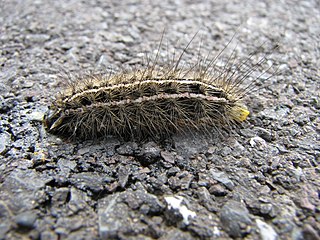
Apantesis arge, the arge moth or arge tiger moth, is a moth of the family Erebidae. The species was first described by Dru Drury in 1773. It is found in North America from Quebec and Maine to Florida, West to New Mexico, North to North Dakota and Ontario.
Apantesis behrii is a moth of the family Erebidae. It was described by Stretch in 1872. It is found from Oregon south to California. It is most common in the Siskiyou and Sierra Nevada ranges. The habitat consists of dry lithosol flood plains and balds in the mountains.
Apantesis bowmani is a moth of the family Erebidae. It was described by Douglas C. Ferguson and B. Christian Schmidt in 2007. It is found in the United States in western Colorado and southeastern Utah. It occurs at elevations between 1,520 and 2,130 meters.
Apantesis brillians is a moth of the family Erebidae. It was described by Schmidt in 2009. It is found in Bryce Canyon National Park in Utah.
Apantesis complicata is a moth of the family Erebidae. It was described by Francis Walker in 1865. It is found on south-eastern Vancouver Island and several Gulf Islands of British Columbia and Washington. The habitat consists of dry Garry oak meadows and sandy beaches.
Apantesis doris, the Doris tiger moth, is a moth of the family Erebidae. It was described by Jean Baptiste Boisduval in 1869. It is found in North America from British Columbia, northern Idaho, Alberta and western Montana. In the east, it is found in the Atlantic Coast provinces and from Nova Scotia to northern Florida and west to central Texas. The habitat consists of open willow/sedge fens and probably other open wetlands in the boreal forest.
Apantesis edwardsii is a moth of the family Erebidae. It was described by Stretch in 1872. It is known only from the San Francisco area in California and Klamath County in Oregon.
Apantesis eureka is a moth of the family Erebidae. It was described by Douglas C. Ferguson and B. Christian Schmidt in 2007. It has been found in the United States along the edges of the Great Basin in central Utah and in southwestern Idaho.
Apantesis f-pallida is a moth of the family Erebidae. It was described by Strecker in 1878. It is found from south-eastern Utah and Colorado south to eastern Arizona, New Mexico and eastern Texas. It has also been recorded from west-central Nevada, and probably also occurs in Mexico.
Apantesis franconia is a moth of the family Erebidae. It was described by Henry Edwards in 1888. It is found in northeastern North America. The habitat consists of dry, rocky, or sandy areas, including pine barrens.

Apantesis incorrupta is an arctiine moth in the family Erebidae, described by Henry Edwards in 1881. It is found from southern Colorado and south-eastern Kansas south through Arizona, New Mexico and western Texas into Mexico and west to south-eastern California. The habitat consists of grasslands and open woodlands.
Apantesis kodara is a moth of the family Erebidae. It was described by Vladimir Viktorovitch Dubatolov and B. Christian Schmidt in 2005. It is found in the Kodar Mountains in Chita Province, Russia.
Apantesis margo is a moth of the family Erebidae. It was described by Schmidt in 2009. It is found in grassland and transitional habitats on the northern Great Plains and Southern Rocky Mountain Front ranges, south to east-central Arizona.

Apantesis nevadensis, the Nevada tiger moth, is a moth of the family Erebidae. It was described by Augustus Radcliffe Grote and Coleman Townsend Robinson in 1866. It is found in the Pacific Northwest of North America, as well as the inter mountain region and the Rocky Mountain states. In Canada, it is found in Alberta and southern Saskatchewan and Manitoba. The habitat consists of deserts, juniper woodlands and open sagebrush range-lands, as well as open forests.

Apantesis ornata, the ornate tiger moth or achaia moth, is a moth of the family Erebidae. It was described by Alpheus Spring Packard in 1864. It is found in western North America from southern British Columbia through the Pacific Northwest to southern California, northern Utah, and western Wyoming and Montana. It is found in a wide range of habitats, including open woodland.

Apantesis phyllira, the phyllira tiger moth, is a moth of the family Erebidae. It was described by Dru Drury in 1773. It is found in North America from Quebec and New England south to Florida and west to Texas, Colorado and Alberta. The habitat consists of dry, open woodland and grassland. The species is listed as endangered in Connecticut.
Apantesis placentia, the placentia tiger moth, is a moth of the family Erebidae. It was described by James Edward Smith in 1797. It is found in the south-eastern United States, from New Jersey to Florida. The habitat consists of dry, sandy open wooded areas, primarily pine barrens.
Apantesis speciosa is a moth of the family Erebidae. It was described by Heinrich Benno Möschler in 1864. It is found from Labrador west to British Columbia and Alaska. The habitat consists of wetlands, bogs and sub-Arctic tundra. The species is listed as endangered in Connecticut.
Apantesis ursina is a moth of the family Erebidae. It was described by Schmidt in 2009. It is found on the Channel Islands off the coast of southern California and in mainland south-western California from Kern County south to San Diego County. It is probably also present in Baja California.

Apantesis virguncula, the little virgin tiger moth, is a moth of the family Erebidae. It was described by W. Kirby in 1837. It is found across most of southern Canada and the United States, from the Rocky Mountains eastward. In the north, the range extends to northern Alberta and Newfoundland. In the south, it occurs along the Rocky Mountain to Apache County in Arizona and New Jersey in the east. It occurs in a variety of open wooded habitats, ranging from marshes, fens and bogs to transition parkland and prairie.






